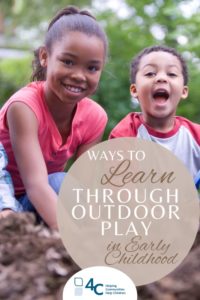
October 2022 – Published by 4-C
For teachers and parents, sending children outside is vital for them to burn off energy. Every hour spent outside is an opportunity for a child to explore the world around them and ignite their imaginations. Every hour spent outside is another chance to learn about the changing features of the natural world. Think about all of the ways a child’s senses are engaged as they smell the the summer wind, feel grass under their shoes, and taste the first flurries of snow on their tongues. A child’s natural curiosity makes them natural explorers. Giving them access to the outdoors allows for endless learning as they use this curiosity to run, jump, dig and climb as they explore the world.
Our attention is often captured by nature in unexpected ways, from the wind blowing across our faces or touching the sand with our toes while at the beach – it’s captivating because we aren’t necessarily paying attention, but our brain is. These instances are examples of Involuntary attention. This occurs when we are aware of something, like the passage of trees in our peripheral vision as we drive by a forest, or the temperature of the sunshine on our skin on a warm day, but we aren’t actively thinking about these sensations or how these experiences affect us.
But what about when we are paying attention? What about the times when we dig our fingers into the sand at the beach and squeeze the grains to feel the prickling sensation against our skin? This is an example of Voluntary attention, when our actions are goal-directed and determined by the relevant task at hand.
Engaging in outdoor play allows children to experience both forms of attention. But how can we help facilitate this kind of exploration?

Safely Explore
- Supervise outdoor play
- Dress appropriately for the weather
- Teach basic safety rules for outdoor play
Let Children Loose
- Allow children to explore
- Observe how they play on their own without offering suggestions
- If they need permission, let them know it’s okay to run, climb, dig, build, and splash
Explore With Them
- Just because you’re an adult doesn’t mean you can’t play, too!
- Participate in your child’s independent exploration by allowing them to direct your involvement
- Encourage them to share their discoveries by asking open-ended questions
Observe the Weather
- Just because it’s raining or snowing doesn’t mean you can’t go outside
- Use the weather to talk about concepts the child is already familiar with, such as temperature, wet versus dry, and how light reflects off of different surfaces
- Practice describing abstract shapes and engaging the imagination by discussing clouds and how raindrops can form into puddles
Animals
- Observe the animals, birds, and insects you see while outside in the yard, on the playground, or while going for a walk
- Encourage your child to mimic the movements they see and noises they hear
- Practice describing what you observe and ask open-ended questions about your child’s perspective
Plants
- Go on a nature scavenger hunt and collect different shapes or colors of leaves
- Describe the details of leaves, the scent of flowers, and the texture of bark
- Count your steps between similar plants to see if you notice a pattern
- Discuss the differences between different types of trees
Although we live in a world that is constantly changing, it has so much to offer us if we take the time to step outside. Take advantage of this giant playground that can spark imaginations as well as provide unique experiences for the children in our lives.
Additional 4-C Resources:
- 4-C Blog: Engaging Outdoor Activities for Kids
- 4-C Pinterest Board: Loose Parts
- 4-C Pinterest Board: Play-Based Learning
Other Resources:
- Frontiers: Do Experiences With Nature Promote Learning?
- K-12 Dive: Unstructured, Longer Play Time Called Key to Early Learning
- Just in Time Parenting: Parenting information when you need it
